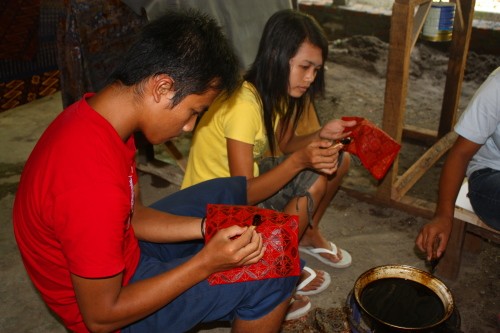Lombok Day Trip - Hand weaving

Jackamy
Paul & Derry Harper
Thu 28 Oct 2010 04:47
|
Thursday 28th October
  We drove through village after
village but we came across this one which had been flooded from the rain they'd
had over the last few days. No one seemed particularly worried and the school
kids just climbed along the edge of the path trying not to get their feet wet.
It did however cause a bit of a traffic jam! I don't think I've every seen that
many vehicles in such close proximity!
  Lombok Bemo's
 How many people can you fit in
one truck!?!
En route to Sukarara we drove
through Lomboks capital, Mataram, where chaotic, traffic choked streets sprawl
more than 10km from east to west. Sukarara's main street is the domain of
textile shops, where you can watch weavers work their looms.
The Indonesian word 'ikat',
meaning 'to tie' or 'to bind', signifies the intricately patterned cloth of
threads that are painstakingly tie-dyed before being woven together.
Traditionally, ikat is made of hand-spun cotton. The whole process of ikat
production - from planting the cotton to folding the finished product - is
performed by women. Once the cotton is harvested, it is spun with a spindle. The
thread is strengthened by immersing it in baths of crushed cassava, rice or
maize, then threaded onto a winder.
Traditional dyes are made from
natural sources. The most complex processes result in a rusty colour known as
kombu (produced from the bark of the roots of the kombu tree). Blue dyes come
from the indigo plant, and purple or brown can be produced by dyeing the cloth
deep blue and then dyeing it again with kombu.
Any sections that are not
coloured are bound together with dye resistant fibre. Each colour requires a
separate tyomg-and-dyeing process. The sequence of colouring takes into
consideration the effect of each application of dye. This stage requires great
skill, as the dyer has to work out - before the threads are woven - exactly
which parts of the thread are to receive which colour in order to create a
pattern of the final cloth. After the thread has been dyed, the cloth is woven
on a simple hand loom.
  Here the ladies are weaving on
hand looms
They can weave a maximum width of
60cm and to make a whole 2 metre cloth can take 2 months. They are making the
patterns, that have been passed down through their families, from memory. Now
you know why they cost so much money!
 Amy getting the hang of
it
  Learning to make batik
designs
Batik is the technique of
applying wax or other dye-resistant substances (like rice paste) to cloth to
produce a design found in many parts of the world, but none is as famous as the
batik of Java. Javanese batik dates from the 12th century, and opinion is
divided as to whether batik is an indigenous craft or imported from India
along with Hindu religious and cultural traditions.
The word 'batik' is an old
Javanese word meaning 'to dot'. Javanese batik was a major weapon in the arsenal
of social status competition in the royal courts. The ability to devote
extensive resources to the painstaking creation of fine batik demonstrated
wealth and power. Certain designs indicated courtly rank, and a courtier risked
public humiliation, or worse, by daring to wear the wrong sarong.
  A mechanical
loom.............The beautiful woven cloths
 |